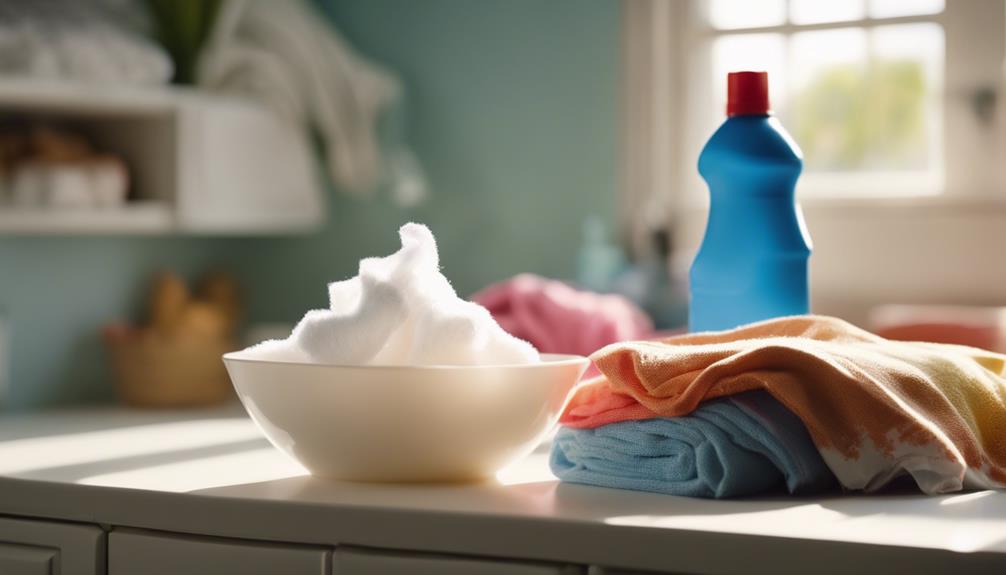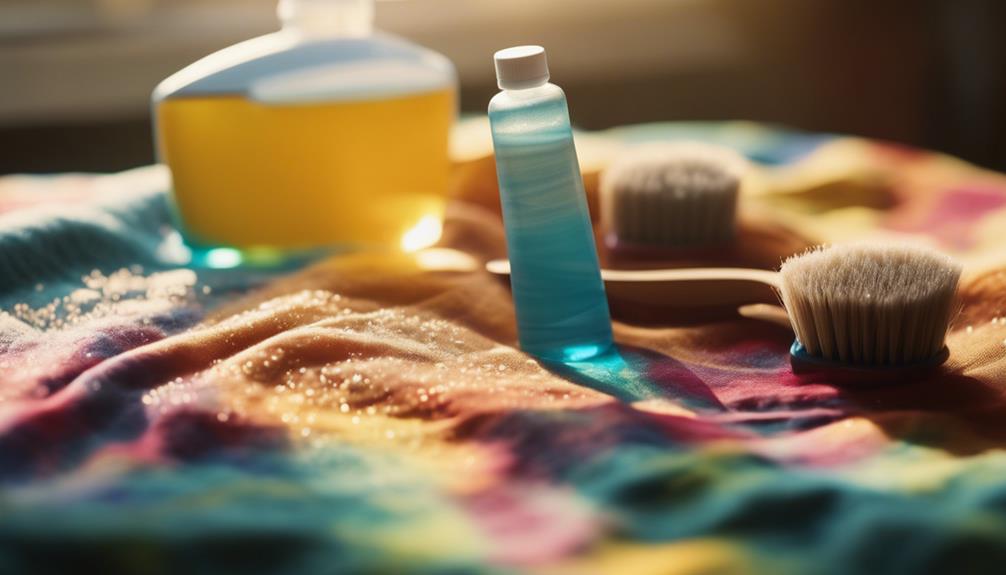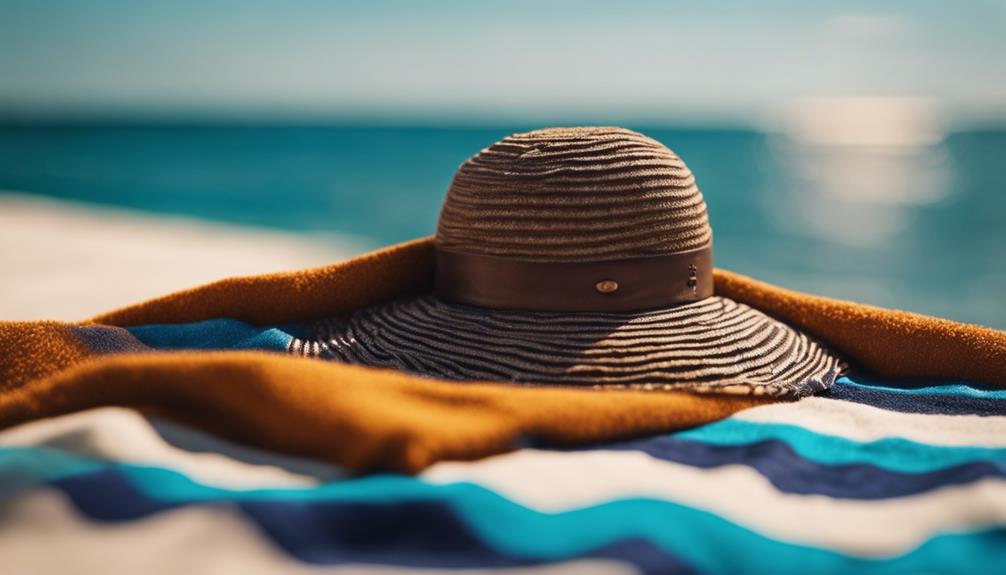In order to remove tanning oil stains from fabrics, it is important to act quickly. Start by delicately blotting the stain with paper towels to absorb excess oil. Avoid rubbing the stain, as it can cause it to spread. Then, apply baking soda to the area and let it sit for 15 minutes before brushing it off. Afterwards, apply liquid dish soap directly to the stain and gently rub it in, allowing it to sit for 5-10 minutes before rinsing with cold water. If the stain persists, use heavy-duty laundry detergent and wash the fabric in hot water, following the care label instructions. Continue to monitor for any remaining stains and explore additional effective methods for dealing with tough spots.
Key Takeaways
- Blot excess tanning oil with paper towels, changing them frequently until no residue remains.
- Sprinkle baking soda on the stain, let it sit for 15 minutes, then gently brush off.
- Apply liquid dish soap directly onto the stain and let it penetrate for 5-10 minutes before rinsing.
- Use heavy-duty laundry detergent for stubborn stains and wash according to fabric care labels.
Stain Assessment and Initial Treatment
Evaluating the tanning oil stain is essential, as it allows you to tailor your cleaning approach effectively. Start by inspecting the fabric to determine if the stain is fresh or set-in. This assessment helps gauge the appropriate treatment method.
Next, check the size of the stain to decide whether to use spot treatment or seek professional help. Be mindful of the fabric's sensitivity to avoid damage during cleaning.
Blot the excess oil gently with paper towels, switching to clean towels frequently to prevent spreading. Press firmly but avoid rubbing, as this can grind the oil deeper into the fibers.
Continue blotting until the towels come away clean, ensuring a solid foundation for further treatment.
Absorption Techniques
After you've blotted the excess oil, it's time to focus on effective absorption techniques to lift the stain from the fabric.
Start by using clean cloths or paper towels to press against the stain, applying pressure from both sides for better absorption. Avoid rubbing, as this can spread the stain.
For extra absorption, sprinkle baking soda on the affected area after blotting. Let it sit for about 15 minutes to draw out more oil.
Once the time's up, gently brush off the baking soda. If you still see residue, repeat the process until the fabric looks clean.
These techniques help contain and lift the stain, preparing it for further treatment.
Pre-Treatment Strategies

To effectively tackle tanning oil stains, start by applying liquid dish soap directly onto the affected area.
Gently rub the soap into the fabric, ensuring it penetrates the fibers. Let it sit for about 5-10 minutes to work its magic before rinsing thoroughly with cold water. If the stain persists, repeat this process.
Here are some key steps to remember:
- Choose a mild liquid dish soap for best results.
- Don't scrub; just blot and rub gently to avoid damage.
- Rinse with cold water to remove both soap and oil.
These pre-treatment strategies set you up for successful stain removal!
Effective Stain Removal
Effective stain removal requires a systematic approach to guarantee that tanning oil marks are thoroughly eliminated from fabrics.
Start by evaluating the stain; fresh stains require different treatment than set-in ones. Gently blot the excess oil with paper towels, changing them often to prevent spreading.
Next, apply liquid dish soap directly onto the stain and gently rub it in, letting it sit for 5-10 minutes. Rinse with cold water to remove the soap.
If the stain persists, use a heavy-duty laundry detergent, rubbing it into the fabric. For stubborn marks, consider an aerosol stain remover.
Always check treated areas for remaining stains and reapply if necessary to achieve the best results before washing your item.
Washing for Best Results

Washing your fabric correctly is essential to assure that any remaining tanning oil stains are thoroughly eliminated. Start by checking the care label to assure you use the right water temperature. Hot water works best to break down stubborn stains, but always confirm it's safe for your fabric.
Use a heavy-duty laundry detergent to tackle tough marks.
Consider adding an oxygen bleach if the fabric allows for it.
Wash the garment separately to avoid transferring oil to other items.
Reassess the fabric after washing; if stains persist, repeat the pre-treatment and washing process before drying.
Following these tips will help you achieve the best results and keep your fabrics looking fresh and clean.
Drying Techniques
How you dry your fabric can considerably impact whether any remaining tanning oil stains are eliminated or set in further.
After washing, always check for stains before drying. If you spot any stubborn marks, treat them again before proceeding.
Use a low heat setting in the dryer to prevent damage to the fabric. High heat can actually set the stain, making it more difficult to remove later.
For delicate items, air drying is your best bet—lay them flat to maintain their shape. Monitor the drying process to guarantee your fabric keeps its integrity.
Once dry, inspect the fabric again for any remaining stains and treat them as needed. Taking these steps can help preserve your fabric's condition.
Prevention Tips and Alternatives

To avoid tanning oil stains on your clothes, apply the product at least 15 minutes before getting dressed. This gives the oil time to absorb into your skin, reducing transfer to fabric.
Here are some effective prevention tips and alternatives:
- Use a towel or cover-up as a barrier while applying tanning products.
- Choose darker clothing to mask any potential stains.
- Limit the amount of tanning oil you use to prevent excess on fabrics.
Frequently Asked Questions
Can Tanning Oil Stains Be Removed From All Fabric Types?
No, tanning oil stains can't be removed from all fabric types. Delicate fabrics may be damaged, while others could absorb oils differently. It's essential to assess each fabric's sensitivity before attempting any stain removal method.
How Long Should I Wait Before Treating a Stain?
Picture a vibrant sunset, slowly fading as you hesitate. You should treat a stain as soon as possible—ideally within minutes. Waiting too long can set it in, making removal much harder later on.
What Household Items Can Help With Stain Removal?
For stain removal, you can use common household items like baking soda, liquid dish soap, white vinegar, and shampoo. These can effectively break down stains when applied correctly, making your cleaning efforts more successful.
Are There Specific Brands of Stain Removers Recommended?
When looking for stain removers, consider brands like OxiClean, Zout, or Shout for effective results. Each offers unique formulations, so try them out, read reviews, and find what works best for your specific stains.
How Can I Test Fabric Sensitivity Before Cleaning?
To test fabric sensitivity, apply a small amount of cleaner on an inconspicuous area. Wait a few minutes, then check for discoloration or damage. If there's no reaction, you can safely proceed with cleaning.
How Can I Remove Tanning Oil Stains From Fabrics If My Moisturizer Sabotages My Tan?
If your moisturizer and tanning impact are causing oil stains on your fabrics, there are a few ways to remove them. Try using dish soap or a stain remover specifically designed for oil-based stains. Gently blot the stain and then wash the fabric according to the care instructions. Avoid heat until the stain is gone.
Conclusion
So, you've mastered the art of avoiding tanning oil stains—only to discover your favorite white shirt has become a canvas for that stubborn glow. Isn't it ironic? You wanted to bask in the sun, not in a sea of laundry woes.
But with these tips, you can confidently enjoy your radiant skin without sacrificing your wardrobe. Remember, a little preparation goes a long way, so don't let those stains dim your shine—embrace the glow and keep your clothes spotless!










